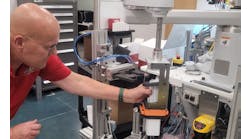Read the full Workforce Week series
Once all the technical, soft and other skills are learned, they can begin to work together, solve problems and optimize processes. This is how experienced engineers, technicians and operators have always solved new problems, and it's still true, even though the Industrial Internet of Things (IIoT) and digitalization have been altering the technological landscape much faster lately.
"We're a 115-year-old company that's gone through several technological changes, and like everyone else, we're in the midst of yet another evolution where we’re seeing the convergence of IT and OT. We traditionally hired mechanical engineers and electrical engineers to produce hardware, but now our managers are looking beyond those traditional skills," says Shane Driggers, vice president of global talent acquisition, effectiveness and diversity at Rockwell Automation, who joined the company to two and a half years ago after 20 years in the software industry. "One essential skill they're going to need in the next five to 15 years is critical thinking for problem-solving and collaboration. Culture is changing within organizations like ours, and people need to be more agile and able to be perpetual learners.
"The question is how to address future skill gaps with today's STEM students and how do we do it with our existing talent base? We’re addressing those questions by developing programs that attract STEM students and internal programs that up-level our own people's skills while they work. Rockwell Automation's corporate strategy is to bring the Connected Enterprise to life. In order to do that, there’s a strong software component, and aligning with it means finding the right people for the right roles that can fill our own skill gaps. I joined with the understanding that we're all in a foot race to bring in new talent from a few new areas, especially the software side. Also, we recognize the importance of diversity of thought and experience which challenges us to ask if we have the right balance between genders and ethnicities."
Driggers reports that, “Sure, there are other technology companies out there with more brand equity who, on the surface, might appear more attractive than Rockwell Automation, but when people come here, they see how innovative we are and that we’re solving problems that make the world work better, more intelligent and more productive. We also spend a lot of time and effort addressing and removing barriers our people face, so they feel more empowered instead of frustrated, and can take intelligent risks to address our customers’ needs and problems.
"It comes down to culture and the readiness of any organization to make changes, There's always a push-pull between wanting to replicate past successes that may no longer work, and balancing historical know-how against those challenging the status quo.
Sometimes people and companies must unlearn and throw out what they've done before to reveal what they can do and need to do. This is where critical thinking, looking at applications in different ways, and getting uncomfortable can push, stretch and drive people into new and innovative solutions.
"We're not asking new or experienced personnel to assimilate, think the way organizations traditionally do, or follow 20-year-old procedures because then they couldn't be their authentic selves to their jobs. Now, we’re asking them to acclimate, and build a relationship with the organization that lets their real selves contribute new thoughts and ideas."







